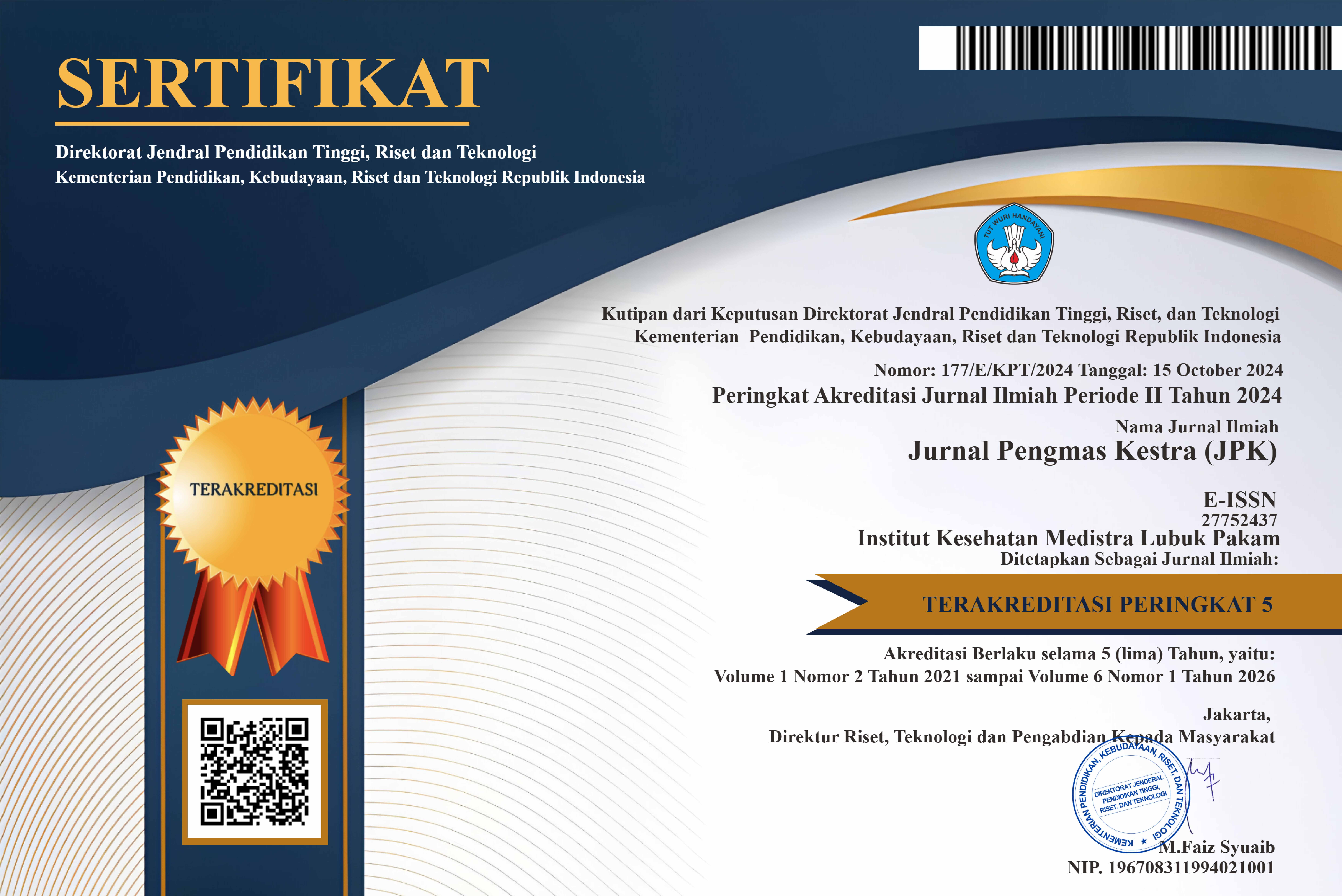Health Education and Uric Acid Examination for the Elderly in Region IV Pasar 0, Working Area of Lubuk Pakam Health
DOI:
https://doi.org/10.35451/jm2ak778Keywords:
Elderly, Hyperuricemia, Health Education, PreventionAbstract
Hyperuricemia, or elevated uric acid levels in the blood, is a common condition among the elderly and may lead to gout arthritis, a painful inflammatory joint disease. This condition is closely related to other degenerative diseases such as hypertension, diabetes mellitus, metabolic syndrome, and cardiovascular disorders. Global data indicate that the prevalence of gout in the elderly reaches 2,505.4 per 100,000 people, making it a significant public health concern. In Indonesia, the prevalence of hyperuricemia in the elderly varies by region, with some reporting up to 18.6%. In Deli Serdang Regency, specifically in Namorih Village, Pancur Batu Subdistrict, a study found that 42.5% of elderly individuals had elevated uric acid levels .This community service aimed to increase awareness and knowledge among the elderly about the prevention and management of hyperuricemia through health education. The method used was an interactive educational session that included lectures and discussions. The activity took place on Apr22, 2025, in Region IV under the working area of Lubuk Pakam Health Center, involving 20 elderly participants.The results showed a significant increase in participants' understanding regarding healthy lifestyle choices, including low-purine diets, regular physical activity, and the importance of regular uric acid screening. Active engagement during discussions demonstrated the participants' enthusiasm to apply the knowledge in their daily routines. .In conclusion, health education using lecture and discussion methods proved effective in enhancing elderly awareness regarding hyperuricemia prevention and control. Similar activities are recommended to be conducted regularly in other regions to improve elderly quality of life .
References
[1] Global, regional, and national burden of gout in elderly 1990–2021. Frontiers in Public Health. Tersedia di: https://pmc.ncbi.nlm.nih.gov/articles/PMC11600630/ 2024.
[2] Prevalence of Hyperuricemia and Associated Factors in Gout. International Journal of Research and Review in Health Sciences. Tersedia di: https://journalijr2h.com/index.php/IJR2H/article/view/154 2024.
[3] Widyanto FW, Curie P. Description of gouty arthritis in the elderly at the Pasar Kuok Batang. Midwifery Journal. Tersedia di: https://midwifery.iocspublisher.org/index.php/midwifery/article/download/1282/1074 2023.
[4] Description of the occurrence of gout in the elderly in Namorih Village. Hearty Journal. Tersedia di: https://ejournal.uika-bogor.ac.id/index.php/Hearty/article/view/16847 2024.
[5] Safiri S, Kolahi AA, Cross M, et al. Prevalence, incidence, and years lived with disability due to gout: findings from the Global Burden of Disease Study 2019. Arthritis Res Ther. 22(1):69. https://doi.org/10.1186/s13075-020-2121-1 2020.
[6] Zhang Y, Chen C, Zhu X, et al. Diet and lifestyle risk factors for gout in Chinese adults: a population-based study. BMJ Open. 11(6):e045956. https://doi.org/10.1136/bmjopen-2020-045956 2021.
[7] Putri EL, Susanti E, Kurniasari D. Penyakit degeneratif pada lansia: Tinjauan faktor risiko dan strategi pencegahan. Jurnal Keperawatan Indonesia. 23(1):20-27. https://doi.org/10.7454/jki.v23i1.1180 2020.
[8] Badan Penelitian dan Pengembangan Kesehatan. Laporan Nasional Riskesdas 2018. Jakarta: Kementerian Kesehatan RI. https://www.litbang.kemkes.go.id/laporan-riset-kesehatan-dasar-riskesdas-2018/ 2019.
[9] Gani LU, Widjaja G, Supriatna M. Patofisiologi dan manajemen gout terkini. Jurnal Penyakit Dalam Indonesia. 9(2):95–102. https://doi.org/10.7454/jpdi.v9i2.1192 2022.
[10] Rahmi H, Nurhasanah, Nurdin. Pengaruh edukasi kesehatan terhadap pengetahuan lansia tentang pencegahan asam urat. Jurnal Pengabdian Kepada Masyarakat. 6(1):45–50. https://doi.org/10.31289/jpkm.v6i1.5123 2023.
[11] Dalbeth N, Choi HK, Singh JA. Gout. Lancet. 397(10287):1843–55. 2021.
[12] Zhu Y, Pandya BJ, Choi HK. Prevalence of gout and hyperuricemia in the US general population. Arthritis Rheumatol. 72(2):313–20. 2020.
[13] Putri DR, Yuliana M, Herawati T. Pengaruh penyuluhan terhadap pengetahuan lansia tentang penyakit degeneratif di Puskesmas. J Kesmas Indon. 17(1):44–51. 2022.
[14] Nugroho E, Setiawan H, Prasetyo D. Prevalensi hiperurisemia pada lansia di komunitas: Studi di wilayah pedesaan. J Gizi Penyakit Metabolik. 6(2):102–8. 2023.
[15] World Health Organization. Integrated care for older people: Guidelines on community-level interventions to manage declines in intrinsic capacity. Geneva: WHO. https://www.who.int/publications/i/item/9789240055193 2023.
[16] Fitriana L, Sari AP, Wulandari S. Hubungan antara pengetahuan dan perilaku hidup sehat lansia pasca penyuluhan. J Promkes. 9(2):120–7. 2021.
[17] Kementerian Kesehatan RI. Peraturan Menteri Kesehatan Republik Indonesia Nomor 43 Tahun 2019 tentang Puskesmas. Jakarta: Kemenkes RI. 2019.
[18] Qin Y, Chen J, Zhang M. Association between uric acid, cholesterol levels, and cardiovascular risk in elderly patients. Front Cardiovasc Med. 9:987654. 2022
Downloads
Published
Issue
Section
License
Copyright (c) 2025 Astri Ulina Saragih, Desideria Yosepha Ginting, Meria Turnip, Risky Yulanda, Santa Natalia

This work is licensed under a Creative Commons Attribution 4.0 International License.
Copyright in each article is the property of the Author.




















